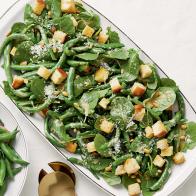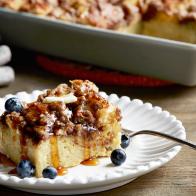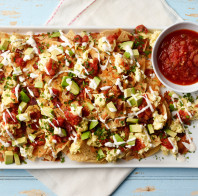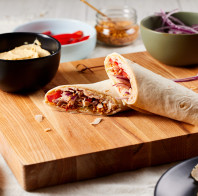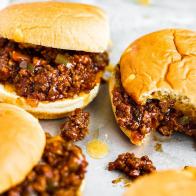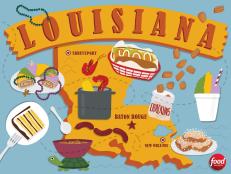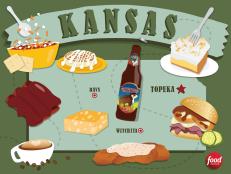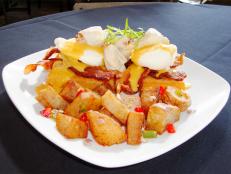50 States of Must-Try Food
From Alabama to Wyoming, here are the dishes that most-define every state in the United States.
Related To:
Photo By: Jackie Alpers ©© 2016, Television FoodNetwork, G.P.All Rights Reserved
Photo By: Kat Robinson ©2016, Television Food Network, G.P. All Rights Reserved
Photo By: Thomas McGovern
Photo By: VisitDelaware.com
Photo By: Lauren Carnes Photography
Photo By: Dimo Raychev
Photo By: Sarah Jane Sanders
Photo By: Justin Tsucalas ©2017
Photo By: Ben Fink
Photo By: Spencer Pernikoff
Photo By: Lynn Donaldson
Photo By: Ann Rachel Vibar
Photo By: EzumeImages
Photo By: Sergio Salvador ©© 2016, Television Food Network, B.P. All Rights Reserved
Photo By: PRABHASROY
Photo By: Jim Beckel
Photo By: Willamette Valley Pie Company
Photo By: Nick Caito ©2016
Photo By: Stephen Stinson/FishEye Studios
Photo By: Staci J Perry
Photo By: Melissa Pasanen
Photo By: Colin Bishop
Photo By: Marion County Convention & Visitors Bureau
Photo By: Jim Klousia
Photo By: Shoshone Rose Casino and Hotel
Welcome to the United Plates of America
Don't just settle for the same dish wherever you go: Each state is packed with iconic local flavors that share its history and define its geography. Whether you're craving Alabama barbecue, Alaskan seafood or a deep-fried favorite in Arizona, here are the dishes you have to try in every state, and the best places to find them.
Illustration by Hello Neighbor Designs
Alabama: Chicken and White Barbecue Sauce
Barbecue sauce takes many forms within Alabama. But the state’s unique contribution to the art form is a creamy, mayonnaise-based white sauce served over smoked chicken. If you’ve never heard of it, you’re not alone: A huge number of red sauces are available at most Southern grocery stores, but white sauce is rarely found outside Alabama. Bob Gibson, the founder of Big Bob Gibson Bar-B-Q in Decatur, is credited with having invented white sauce back in 1925, and his original Decatur location has been making it ever since.
Alaska: King Crab
Bisques, cakes, rolls, legs, buckets, clusters and combos: Alaskans love their crab. At Tracy's King Crab Shack in Juneau, Bering Sea king crab is the star. Tracy's crab cakes come with a sweet and spicy dipping sauce; a bucket holds half of a king crab plus a killer claw. They also boast the "best legs in town."
Arizona: Chimichangas
One day in the mid-1950s, El Charro Café’s founding chef, Monica Flyn, accidentally invented the chimichanga when she dropped a burro (a big burrito) into the deep fryer. On that day a legend was born. Now, the crisped, packed dish is available at the Tucson and Oro Valley restaurants in sizes from the bite-size mini to their supersized USA Today chimi, which is about the size of a rolled-up newspaper, full of chicken, beef, shrimp, vegetarian beans or carnitas.
Arkansas: Fried Pickles
In 1963, Bernell "Fatman" Austin of the Duchess Drive-In first battered and deep-fried dill pickle slices and sold them for 15 cents for a basket of 15 to employees of the nearby Atkins Pickle Plant. Though both the restaurant and its proprietor are long gone, fried pickles have become an Arkansas mainstay, and the wafer-thin versions served at Sassy's Red House in Fayetteville is one of the finest. They're usually served with ranch dressing, though you can also find remoulade or ketchup, depending on the restaurant.
California: Avocado Toast
Californians are fiercely proud of their incredible avocados; they've turned the creamy green fruit into an everlasting fad. Aside from the ubiquitous guacamole throughout the state, avocado shows up in everything from burgers to ice cream, but one of the most-popular ways to enjoy avocados is mashed high on top of toast. There are endless ways to modify avocado toast topped with caviar, feta, radishes and then some, but keeping it simple can be just as delicious. At Dinette in Los Angeles’ trendy Echo Park neighborhood, an order of avocado toast gets you a Texas-toast-size slice of rustic bread topped with a limey, fresh heap of crushed avocado seasoned with chile flakes, parsley and delicate snowflake-like flecks of salt. You’ll need a fork and knife to cut through this toast steak.
Colorado: Lamb Chops
Lamb is one of Colorado's most-famous foods. So while the steaks at Elway's, a quartet of carnivorous emporiums named for the former Denver Broncos quarterback, are exceptional slabs of beautifully seasoned beef well worth a splurge, set your sights on the lamb chops and fondue. The bucket-list starter parades a trio of lightly gamy chops - the lamb is sourced from Mountain States Rosen, a ranch in Greeley - that expose remarkably tender flesh throttled with flavor. The chops really don't require a sidekick, but the warm cheese fondue, creamy with pepper Jack and peppered with a variety of fresh chiles, sort of makes you want to snort it. It's been said by many that Colorado lays claim to the best lamb in the world; Elway's chops are proof positive that they're right.
Connecticut: White Clam Pizza
Few other pizzas are as revered as Frank Pepe Pizzeria Napoletana’s white clam pizza. Pepe has served its charred and chewy pizzas since 1925 on New Haven’s historic Wooster Street. The elder statesman of New Haven’s well-regarded pizza scene, Pepe’s continues to draw long lines trailing down the block for a chance to enjoy a taste of New Haven’s history from its coal-fired brick ovens. The clam pie, in particular, has inspired hundreds of imitators with few matching the intoxicating combination of Romano cheese, fresh garlic, olive oil, parsley and clams. Combining the Connecticut shoreline’s love of seafood with Pepe’s signature chewy and charred crust, Pepe’s is the place for an authentic Connecticut pizza experience.
Delaware: Fries with Vinegar
When in Delaware, the beach is everyone's summer hideaway from everyone else, and when at the beach, a stop for a tub of hot fries at Thrasher's on the boardwalk is as obligatory as a nap on the sand. A liberal dousing with cider vinegar is not quite as mandatory, but comes highly recommended by devotees of the snappy, salty, memory-making result. Just keep watch for dive-bombing seagulls.
Florida: Key Lime Pie
Florida’s most famous export besides oranges may be Key Lime Pie. Named after the small, tart, aromatic limes commonly associated with the Florida Keys, the meringue-topped pie combines the tangy lime juice with sweetened condensed milk and egg yolk, all poured into a graham cracker crust. Variations appear on virtually every menu south of the Georgia border, but not all key lime pies are created equal. (Rule: Never trust a bright green filling!) The version found at Ma’s Fish Camp in Islamorada is prepared according to traditional Conch guidelines, well-balanced honeyed, citrusy base, piled high with sweet meringue.
Georgia: Boiled Peanuts
Ground nut, goober, pindar nut or peanut. Call them what you like, Georgia’s official state crop is a worldwide favorite. After all, where would the PB&J be without the all-important "P"? Particularly in peanut country, though, boiled peanuts (pronounced "boll-ed peanuts" in a Southern drawl) are a crowd pleaser. The uninitiated might liken their tender texture to edamame; since they’re cooked with salt and spices, they don’t need any additional seasoning. At Augusta’s Finch & Fifth, boiled peanuts are a year-round favorite way to start the meal. The kitchen sources about 50 pounds of peanuts each month from a nearby farm and boils them in Pabst Blue Ribbon beer with their own secret spice blend.
Hawaii: Shave Ice
Shaved ice — or shave ice, as locals call it — is so much more than a snow cone. In Hawaii, the most-popular shave ice stands sell fluffy mountains of ice, shaved to a nearly fluffy consistency with very sharp blades. Ululani’s arguably has the fluffiest and finest on Maui, if not the state, taking it up a notch by offering a wide variety of popular and exotic flavors like lychee, tiger’s blood, wedding cake, pickled mango and wet lemon peel. Its shave ice is so popular that Ululani’s now has six locations around Maui, but the main one is in Lahaina, on Front Street, right by the ocean.
Idaho: Jim Spud Baked Potato
Taxidermized deer and buffalo heads peer down from the walls at Pioneer Saloon, a rustic steak-and-potatoes mainstay on Ketchum’s Main Street. The space is also decked out with statues of cowboys on bucking horses and a cocked shotgun owned by Ernest Hemingway. After a long day on the ski slopes at Baldy, patrons swear by the gargantuan Jim Spud, an Idaho potato loaded with 6 ounces of teriyaki steak scraps, caramelized onions, butter, sour cream and a mound of melting cheddar cheese. But only the hungriest should go solo: This is a beast that’s best shared.
Illinois: Deep-Dish Pizza
Because it’s a knife-and-fork affair that threatens your cardiac health, most Illinoisans eat deep-dish pizza only a few times a year. But when they do, the best places to get it are the restaurants run by the sons of deep-dish pizza co-inventor Rudy Malnati Sr.: Lou Malnati’s and Pizano’s (owned by Rudy Malnati Jr.). Rudy Jr.’s spot gets the edge over his brother’s, because his crust is more buttery and golden and a little less hefty. The sauce is delectably salty and ripe with tomato. You can get any topping, but if you want to keep it real, stick to — as the locals pronounce it —"ssaaah-sidge."
Indiana: Breaded Pork Tenderloin Sandwich
If the Hoosier state had an official sandwich, this would be it. The deep-fried breaded pork tenderloin sandwich is big in Indiana — literally. The pork is pounded out, breaded, deep fried and typically served on a bun that looks conspicuously small compared to the meat, but that’s part of the appeal. At The Mug, a "farm-to-curb" drive-in in Greenfield with a second location in Indy’s Irvington neighborhood, that pork is pasture-raised on local farms.
Iowa: Sweet Corn
If drive more than a few blocks in Iowa, you’ll likely see a few sprouting ears of corn growing. In fact, the saying is, "knee-high by the fourth of July." Come mid-summer, farmers pack truck beds full of sweet corn to sell at markets and on street corners. There are even festivals dedicated to the kernels. One favorite hybrid is the bi-color peaches and cream, known for its exceptionally sweet flavor, and sold by Grimes Sweet Corn.
Kansas: Barbecue Ribs
Kansans like to get their fingers sticky eating well-smoked barbecue ribs. The best are found at HHB BBQ in downtown Topeka. Pit Master-Owner Ed Moege coats the baby backs in his own special rub and then transfers them to the smoker out back. Towards the end, he smothers them with the house sauce. The result is close-to-fall-apart-tender ribs with just the right amount of smoke. The ribs are available for lunch on Fridays and for dinner every weeknight. They go well with a side of cheesy potatoes or smoked mac and cheese.
Kentucky: Hot Brown
In 1926 Chef Fred Schmidt at Louisville’s Brown Hotel created a savory, creamy, hot, open-faced turkey sandwich intended to recharge the energies of the hotel’s nightly dinner-dance patrons. Schmidt layered sliced turkey on toast, covered it with Mornay sauce, tucked in some Roma tomato halves and toast points, ran the dish under a hot broiler and added crisp bacon slices as the topper. The Hot Brown, still available daily at the Brown Hotel, has its own webpage, which includes the original recipe. It remains popular enough in restaurants across the commonwealth that it has spawned its own best-of competitions.
Louisiana: Beignets
Pillowy fried dough coated in a blanket of powdered sugar: Is there anything to argue with here? Nope. Café du Monde sets the global standard for puffy, hot-out-of-the-fryer beignets. Open 24 hours a day, the French Quarter cafe serves beignets around the clock to satisfy cravings whenever they strike. You’re probably not going to leave without a powdered-sugar mustache — and let’s be honest, powdered-sugar pants, too. Chicory coffee is practically mandatory for beignet-dipping bliss.
Maine: Lobster Roll
Maine is practically synonymous with lobster, meaning excellent lobster rolls. Red’s Eats has been an iconic figure along Route 1 in Wiscasset since 1954. In 2015, the tiny lobster shack — with its outside picnic table seating and notoriously long lines — served 14 tons of fresh lobster in its signature rolls during its six-month season. 14 tons. Even with all of the lobster roll options in Maine, Red’s sets itself apart with its generosity: The staff don’t measure the meat, they just "pile high." If lobsters are shedding their shells and tails are small, you may find three tails on your buttery bun. There’s easily more than one lobster’s worth per roll — and no bib necessary.
Maryland: Steamed Crabs
Nothing shouts Maryland quite like blue crab, the Chesapeake Bay crustacean prized for its sweet, white meat. Annual catches have been on the decline in recent decades, but conservation efforts are helping to bring this state treasure back in force. The purest way to enjoy these clawed beauties is the simplest: steamed and dusted with a piquant spice mix (like Old Bay!). Order them at crab houses across Maryland — think Cantler's Riverside Inn in Annapolis or Costas Inn just outside Baltimore — where steamed crabs are sold by the dozen and dumped directly atop tables covered in newspaper or brown butcher paper. Prepare to get messy, since no utensils are required but your own two hands and the supplied crackers and mallets.
Massachusetts: Clam Chowder
Legal Sea Foods — or Legal, as it is fondly known here — opened in 1950 in Cambridge and has become a New England institution, now counting dozens of outposts along the eastern seaboard. (Disclosure: This writer's mother worked here decades ago!) Owner Roger Berkowitz recalls: "Initially we had done only fish chowder, [but] we tried an experiment with clam chowder and it went over well. ... As soon as we introduced it, I thought, 'Boy, why didn't we do that before?'" Today the clam chowder — featuring fresh clams, salt pork, potatoes, light cream and a homemade fish stock that Berkowitz thinks is key — outsells fish chowder 20 to 1.
Michigan: Pasty
The Cornish created the pasty, but when Cornish immigrant copper miners brought the meat hand pies to Michigan, the dish took on new characteristics. Often found in the Upper Peninsula (U.P.), pasties were later adopted by the Finnish, who claimed them as their own. Regardless of origin, the pasty has become a staple Michigan food for the Yoopers (those who live in the U.P.), who even throw a festival to celebrate it. Some of the best pasties can be found at Lawry's, a family-owned pasty shop that opened in 1946. They still serve the traditional meat variety stuffed with beef, potato, onion and rutabagas, but also offer mini pasties, and garden vegetable versions as well.
Minnesota: Hot Dish
It might look like a casserole to you, but ask any Minnesotan what they call this combination of beef or chicken, veggies and canned cream of mushroom soup — traditionally topped with Tater Tots — and the response will be "hot dish." This easy to make casserole can be found everywhere from church suppers to family reunions. It’s even at the center of a highly competitive culinary competition that pits the state’s congressional delegation against one another to see just who makes the best hot dish. While it’s mostly a dish made at home, The Mason Jar, located in Eagen, serves a version that will remind you of your grandmother’s cooking, if your grandmother made everything from scratch. Ground beef is browned and stirred into a rich and creamy mushroom sauce, and draped over tots. Melted cheddar cheese and a few more tots crown the top for rib-sticking glory.
Mississippi: Biscuits
Natchez, Mississippi, is famous for its antebellum mansions and riverboats. It’s also the Biscuit Capital of the World. Regina Charboneau, a seventh-generation native daughter, helped her hometown earn the official designation in 2008 and launch a biscuit festival, with a cook-off, demos and a crowning of a biscuit queen. A Paris-trained chef, Charboneau prepares extra-buttery, flaky biscuits that have become legend. Her biscuit recipe is no secret. She’s shared the method in cookbooks and cooking classes, and with national press.
Missouri: Toasted Ravioli
Toasted ravioli — which are, in fact, fried — are exactly what they sound like: crispy, breaded ravioli. They’re typically filled with seasoned ground meat and served with marinara sauce, but not so at upscale barbcue joint Salt + Smoke. No, sir! They fill their ravioli with chopped oak-smoked burnt ends, topped with a sprinkle of garlic and herbs and served with an Alabama-style white barbecue dipping sauce. Resistance is futile.
Montana: Huckleberry Ice Cream
Wilcoxson’s Ice Cream is as much a Montana dietary staple as a hearty steak or a juicy hamburger. Boasting 58 flavors, including local strongholds Bobcat Batter and Chocolate Runs Through It, the Livingston-based company has been filling bellies throughout Big Sky Country since 1912. Sandwich shops like The Pickle Barrel (in Bozeman, Belgrade, Livingston and Billings) whip Wilcoxson’s into milkshakes or serve it in softball-size scoops on cones. Wilcoxson’s Huckleberry Ice Cream Bars can be snapped up at most any grocery story, gas station or hardware store between Yellowstone and Glacier with a "Proudly Serving Wilcoxson's" sign displayed in the front window.
Nebraska: Tin Roof Sundae
The tiny town of Potter, Nebraska, is home to this big treat, an ice cream sundae that played with sweet and savory combinations long before it became a trend. Harold Dean "Pinky" Thayer came up with the combination, which tops chocolate ice cream with chocolate sauce, then a scoop of vanilla ice cream, then warm marshmallow cream. The whole thing gets a sprinkling of skin-on Spanish peanuts. The Potter Sundry in town is the place to get one, and it draws tourists from around the globe to sample the dessert, especially in the summer.
Nevada: 3 a.m. Steak & Eggs
Known lovingly as "steggs," the no-frills late-night/early-morning steak and eggs plate is a cherished ritual for casino workers, tourists and night owls alike. Among the many 24-hour diners near the Las Vegas Strip, the Ellis Island Cafe rises to the top. Established in 1968, the local favorite aims to please with a generously sized New York strip, two eggs, toast and potatoes, all for a price hovering at or below ten dollars.
New Hampshire: Poutine
Natives with a strong French-Canadian heritage, especially near Manchester, carry a gravy-slathered torch for this iconic cheesy French fry combination. The dish is offered as a basic recipe in many bars around town, but at New England Tap House Grill in Hooksett, the fries are given a Parmesan and fresh rosemary dusting and the gravy is enriched with a sherry-peppercorn demiglace, then a heady spritz of truffle oil. Authentic: No. Worthy: Yes.
New Jersey: Disco Fries
Disco fries are New Jersey’s answer to Canada’s poutine. The Tick Tock Diner in Clifton lays claim to originating them, as do several other establishments in the Garden State. But it’s the Tick Tock that most Jersey residents think of when they’re craving crisp French fries smothered in melted mozzarella and warm gravy. While the dish has been around longer than the days of disco, the name allegedly came about in the 1970s at diners when John Travolta wannabes stumbled in after a night of dancing and drinking. Known primarily in North Jersey, the dish has been creeping down south in recent years.
New Mexico: Frito Pie
Texas and Santa Fe both lay claim to Frito Pie. Each side has its arguments and documentation, but at Española's El Parasol the answer is, "Who cares?" Everyone — even Texans —enjoys the crisp and salty corn chips blanketed in red chile sauce and topped with beans, ground beef, cheese and lettuce. It's messy, filling and decadent. Start with a fork, but switch to a spoon when the chips begin to wilt to fully revel in this so-wrong-it's-right kind of creation.
New York: Buffalo Wings
The favorite finger food of sports fans, Buffalo wings get their name from the city of their inception. There’s seemingly no such thing as a bad wing in Buffalo, but the establishment that rises above all others is the place where the wing was born. It started almost by accident as an experiment, on March 4, 1964. Anchor Bar co-founder Teressa Bellissimo’s son Dominic asked his mother to whip up a snack for his intoxicated friends late one night while he was tending bar. Teressa deep-fried the wings that were normally used as the base for stock, then flavored them with a secret sauce. While similar recipes have become mainstays on menus across the US, Teressa’s tightly guarded master recipe is only available at Anchor Bar.
North Carolina: Lexington-Style Barbecue
When it comes to choosing sides in the barbecue battles, it all comes down to the sauce. In the Lexington area, that means a tangy, vinegar-based blend with ketchup, salt, pepper and an occasional "secret" spice or two. It’s tradition to dip the pork shoulder meat into the sauce, rather than pouring it on. Don’t be confused when you see "barbecue slaw" on the menu. It’s not cooked, but dressed with this favored sauce in lieu of bland mayonnaise. Lexington’s legendary Barbecue Center has been operating since the 1950s and continually wins over new generations of fans, including Bobby Flay, who visited on BBQ with Bobby Flay.
North Dakota: Cheese Buttons
These dumplings may follow one general recipe, but but they go by many names. Ukrainian speakers call them varenyky or pyrohy, while the Czechs say they’re vareniki. In Polish, they’re called pierogi. In German, they’re kase knoephla. Second- third- and fourth-generation North Dakotans call them cheese buttons, which seems an apt name for plump little dumplings stuffed with creamy cottage cheese. They’re typically boiled or pan-fried in butter and topped with cheese, scallions or sautéed onions and a drizzle of fresh or sour cream. Buy frozen cheese buttons at the Ukrainian Cultural Institute in Dickinson or order freshly boiled dumplings by Tuesday and pick them up on Wednesday.
Ohio: Cincinnati Chili
Thanks to Skyline Chili, scores of Americans living outside the Queen City have discovered the matchless joys of Cincinnati-style chili, which fans know has little to do with that Texas-reared version. At countless "parlors" throughout the region, chili refers to that thin, mildly spiced meat-based sauce that is ladled over Coney dogs or big platters of spaghetti. Skyline and early rival Gold Star both cast a very wide net throughout the region and beyond, but many locals prefer to get their two-, three-, four- and five-way plates at local legend Camp Washington, honored by the James Beard Foundation as an American Regional Classic. Whether you prefer yours topped simply with finely shredded cheddar cheese or the works — cheese, onions and beans — it’s a comfort classic, best enjoyed with hot sauce and oyster crackers.
Oklahoma: Steak
The heavyweight champion of diners’ affections in Oklahoma is a good steak, and nobody has done it longer than Cattlemen’s. Born as Cattlemen’s Café in Oklahoma City’s infancy, and won in a dice game after World War II, the institution evolved into Cattlemen’s Steakhouse in 1990. Owner Dick Stubbs broadened the menu to include prime beef to go along with choice cuts, creating dishes that draw droves from around the world. The restaurant serves its hearty steaks at breakfast, lunch and dinner. The steak earns Cattlemen’s a lot of attention, but the restaurant is almost as popular for its lamb fries and salad dressing.
Oregon: Marionberry Pie
Marionberries were bred at Oregon State University by crossing two types of blackberries. Because they don’t ship well, most fresh marionberries are used in-state to make muffins, jam, ice cream and the beloved fresh pie. The Willamette Valley Pie Company in Salem, which processes an average of 12 million pounds of berries per year, makes three kinds of marionberry pie and lets you pick your own marionberries in the summer.
Pennsylvania: Philly Cheesesteak
Thinly sliced and griddle-fried beef, with or without onions, topped with Cheez Whiz, American or provolone (you choose), and piled into a long crusty roll — this is the Philly icon. Though Pat’s and Geno’s are the household names, many locals prefer John’s Roast Pork, where the steak is cooked to order and the rolls are seeded. The family-run sandwich shack has been around since the 1930s, and though named for another classic Philly sandwich, it's the local go-to spot for cheesesteaks too. Opt for sharp provolone rather than Whiz or American, and get it with onions (just say "wit" — it’s faster and lines are long) to pack in maximum flavor.
Rhode Island: Coffee Milk
Nearly 100 years old, coffee milk is so iconic here that it became the official state drink in 1993. Coffee-and-sugar syrup is spun with frosty milk for an ice cream-free riff on a milkshake that’s as addictive as it is simple. You'll find it at coffee shops across Rhode Island, but skip the versions made with artificial ingredients and try those prepared with good coffee and sugar. Dave Lanning, CEO of Dave’s Coffee in Providence and Charlestown, roasts and cold-brews Brazilian beans and simmers the result with pure cane sugar to make the beloved syrup that forms the drink’s base. (People even buy the syrup online!)
South Carolina: She-Crab Soup
A rich soup that’s similar to bisque, she-crab soup traditionally blends cream, fresh crabmeat, red-orange roe from the female crab (hence the 'she-crab') and a splash of sherry. It can be found on menus from the Lowcountry to the Upstate. South Carolinian chef Sean Mendes serves one of the state’s best bowls — using his family recipe — at Folly Beach’s Roadside Seafood. Another classic version has been a signature dish since the day Soby’s opened their doors in Greenville in 1997. And it’s also a 55-year fave that garners more adoration than any other dish on the menu at the iconic Sea Captain’s House in Myrtle Beach.
South Dakota: Lefse
Lefse is a Norwegian-American staple. The flat potato bread is best enjoyed with a spread of butter and, for the sweet tooth, sprinkled with sugar, and rolled up. Scandinavian grandmas, aunts and moms are keepers of the family recipe and, when grandma is ready to give it up, they inherit the lefse grill, turning stick and corrugated wooden rolling pin. Lefse is iconic to South Dakota but it, and similar dishes influenced by Norwegian culture such as krumkake, sandbakkels and rosettes, are made in home kitchens, not restaurants. When you must venture out of grandma’s kitchen, buy packaged lefse at participating Hy-Vee stores or at bakeries and church bake sales at Christmastime.
Tennessee: Nashville Hot Chicken Sandwich
Legend goes that Nashville Hot Chicken was invented in the 1930’s when a scorned lover tried to exact revenge by spicing up Thornton Prince’s fried chicken with an insane amount of pepper until it was an infernally dark red color and blazingly hot in flavor. It turned out he loved it and asked his paramour to cook more of it for him and his friends, eventually opening a restaurant to serve it to the masses. Today, there are multiple places to buy and try the piquant poultry, but the current generation of the Prince family still serves the original version, which many consider to be the best.
Texas: Brisket
Warning: Franklin Barbecue’s brisket will take five hours off your life — not just because of the heavy oak-smoked rush of flavor that’s literally unlike anything else in the universe, but because scoring a bite requires arriving at the Austin institution around sunrise and waiting until its doors open at 11 a.m. It’s a rite of passage among barbecue snobs that isn’t for the weak of knees, but once you reach the front of the line, you’ll be rewarded with a bite of food you’ll never forget and that showcases the best of Texas’ barbecue traditions.
Utah: Fry Sauce
There are few better ways to enjoy french fries than with a side of fry sauce. Consisting of ketchup, lemon juice, eggs and some secret ingredients, fry sauce tastes similar to Thousand Island dressing. Though many restaurants and fast food joints serve their own versions around Utah, Arctic Circle, a popular Midvale-based hamburger chain, claims to have put the elevated dipping sauce on the map in the 1950’s. Due to popular demand, the chain now sells 16-ounce bottles. And no judgment here if you decide to slather it on your cheeseburger, too.
Vermont: Apple Pie (with Cheddar)
Like many Vermonters, multigeneration apple orchardist Ray Allen believes "Apple pie with cheese is like a hug without the squeeze." And Allen knows apple pie. The Allenholm Farm apple orchard in South Hero has been in his family since 1870, and he’s prepared the very flaky crust for each of the 2,000-plus pies annually sold at the orchard since 1990, when his wife dared him to perfect a pie recipe. New Englanders also believe in pie for breakfast, and, at 80, Allen has sure earned his slice.
Virginia: Peanut Soup
A mix of onion, celery, chicken stock and peanut butter lays the base for this hearty soup that was popular in Colonial Virginia. Its roots are African, but the version served on Fridays at 1776 Log House Restaurant was adapted from one that was once served at the historic Hotel Roanoke, which was constructed in the 1880s. The family-run restaurant is located in tiny downtown Wytheville in the western part of the state, and is set in an actual log cabin built in its namesake year of 1776.
Washington: Seafood Chowder
Kevin Davis has been making chowder his entire adult life. So it makes sense that when he opened his Pike Place Market restaurant, Steelhead Diner, a decade ago, he put chowder on the menu. Initially, he used manilla clams, but because he was selling so much chowder, it became an economical nightmare. His new recipe uses razor clams, and it’s no less flavorful. He follows a very specific recipe that includes fennel, leek, potatoes, apple wood-smoked bacon, cream, butter, thick-cut razor clams and razor clam juice. The entire dish is drizzled with truffle oil sourced from nearby La Buona Tavola truffle cafe.
West Virginia: Pepperoni Rolls
Created in West Virginia by Italian immigrants needing a hearty, delicious and, most importantly, non-perishable lunch to take underground while working the coal mines, pepperoni rolls are now the state’s official food. Some modern-day takes are topped with sautéed onions, peppers and marinara, but you’ll want to start with the original recipe. Featuring spicy sticks of pepperoni baked inside a warm, fluffy roll, the banner version is served at Tomaro’s Bakery, located in the heart of Clarksburg’s Italian community.
Wisconsin: Fried Cheese Curds
Cheese curds are small, bumpy lumps of (usually) cheddar that are collected before the cheese has formed into blocks. Kids of all ages love them for their moist, springy bite and mild, salty flavor. Try to get them as fresh as possible, before they are fully chilled, because that’s when they squeak. Yes, this cheese makes noise when you eat it. Fresh cheese curds are hugely popular in Wisconsin, but deep-fried cheese curds have attained cultlike status. Batter-fried and served with tasty dips, they’re on the menu at such restaurants as the landmark Lakefront Brewery in Milwaukee. Guess what goes really well with them? Yep: beer.
Wyoming: Fry Bread
In Lander, Deka-Guy Hee (Shoshone for "The Eating House") at Shoshone Rose Casino and Hotel gives guests a taste of the state’s American Indian heritage via Fry Bread, a popular Indian taco dish. The platter is like a taco salad, but it features housemade fry bread instead of a taco shell. The fry bread serves as a palatable landing for cheese, lettuce, tomatoes and ground taco meat.


